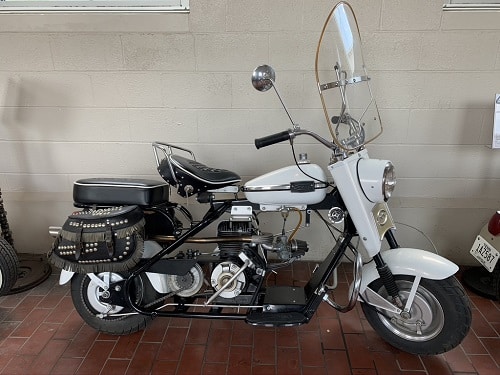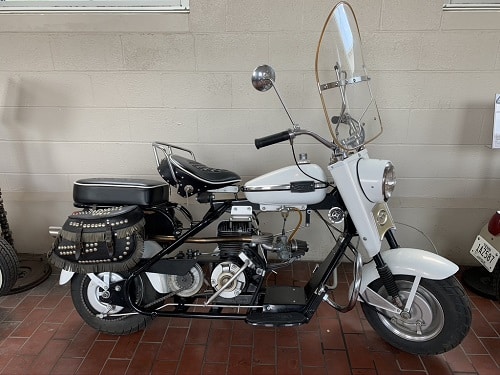
Cushman Standard Cast Iron Eagle- 1957

The Cushman family began making farm machinery and two-cycle boat motors in Lincoln, Nebraska and founded Cushman Motor Works in 1902. After some success, including the development of the famous single-cylinder four-stroke “Husky” engine (1922) and inevitable down-turns, by 1933 the Cushman family was no longer associated with the company. As it was dissolving, John F. Ammon of the Easy Manufacturing Co. who had contracted Cushman Motor Works to produce castings for their open-back geared pumping windmills, then acquired Cushman Motor Works. He merged the two companies under the better-known Cushman name and appointed his son Charles as CEO. In 1936, a young boy rode into their plant on a bike that was powered by an adapted Cushman washing machine motor, looking for parts. Charles realized the opportunity and had his sons Robert and William design the “Auto-Glide” scooter to boost the sales of the Husky engine. Priced at around $150, while retaining 129mpg, the scooter was widely acclaimed as an alternative to the automobile and was a bit of a luxury during the gas rationing of the War.
During the Second World War, when production of military equipment ramped up in the US, Cushman aided by delivering the Model 53 single-cylinder 4.6 hp Cushman “Airborne” or “Parascooter”. It had been specifically designed to be air-dropped alongside paratroopers because the scooters were quiet, easily maneuverable, and able to travel up to 100 miles on its one-gallon tank.
In 1949, after the war, Cushman introduced the Eagle, its most popular model. It was based on the idea of styling a scooter that included all the design features of the big American motorcycles of the day, such as Harley-Davidson and Indian. This was a departure from the popular step-through scooter design of the day, a feature offered on most other Cushman models as well. The Eagle’s bodywork was kept to a minimum. Without excessive panels, the engine was proudly on display to show off its air-cooled flathead and a chrome-plated exhaust pipe shooting back to the right. Cushman called the styling “streamlined,” which meant with lots of shiny metalwork, instead of actual aerodynamics.
With its contoured fenders, teardrop fuel tank, sprung saddle, wide handlebars, and tubular steel frame, it proved to be an instant success. Ads listed the buyer’s choice of four colors; Black, Huntsman Red, Cascade Blue, and Starmist White. The Eagle was available with a number of accessories. The more stylized and better equipped Super Eagles and Silver Eagles got up to 8 hp from the Super Husky engine. The Standard Cast Iron Eagle as seen here was a fully optioned model featuring an electric starter, a buddy seat, saddle bags, turn signals, twin mirrors, speedometer, and windshield.
By 1958, Cushman had manufactured 15,000 total scooters. Production ended in 1965, but some remaining Eagles were sold as 1966 models. Cushman would go on to produce golf carts, industrial vehicles, and turf maintenance equipment. There was also a Belgian licence-production of Cushman scooters under the label Belgian Cushman.
Specifications:
Manufacturer: Cushman Motor Works
Country of Origin: United States
Engine: Husky air-cooled single cylinder, four-stroke, 7.95 hp
Transmission: Belt-driven, 2-speed
Top Speed: 50-60 mph
Years of Production: 1949-1966
Number Produced:15,000 total scooters
